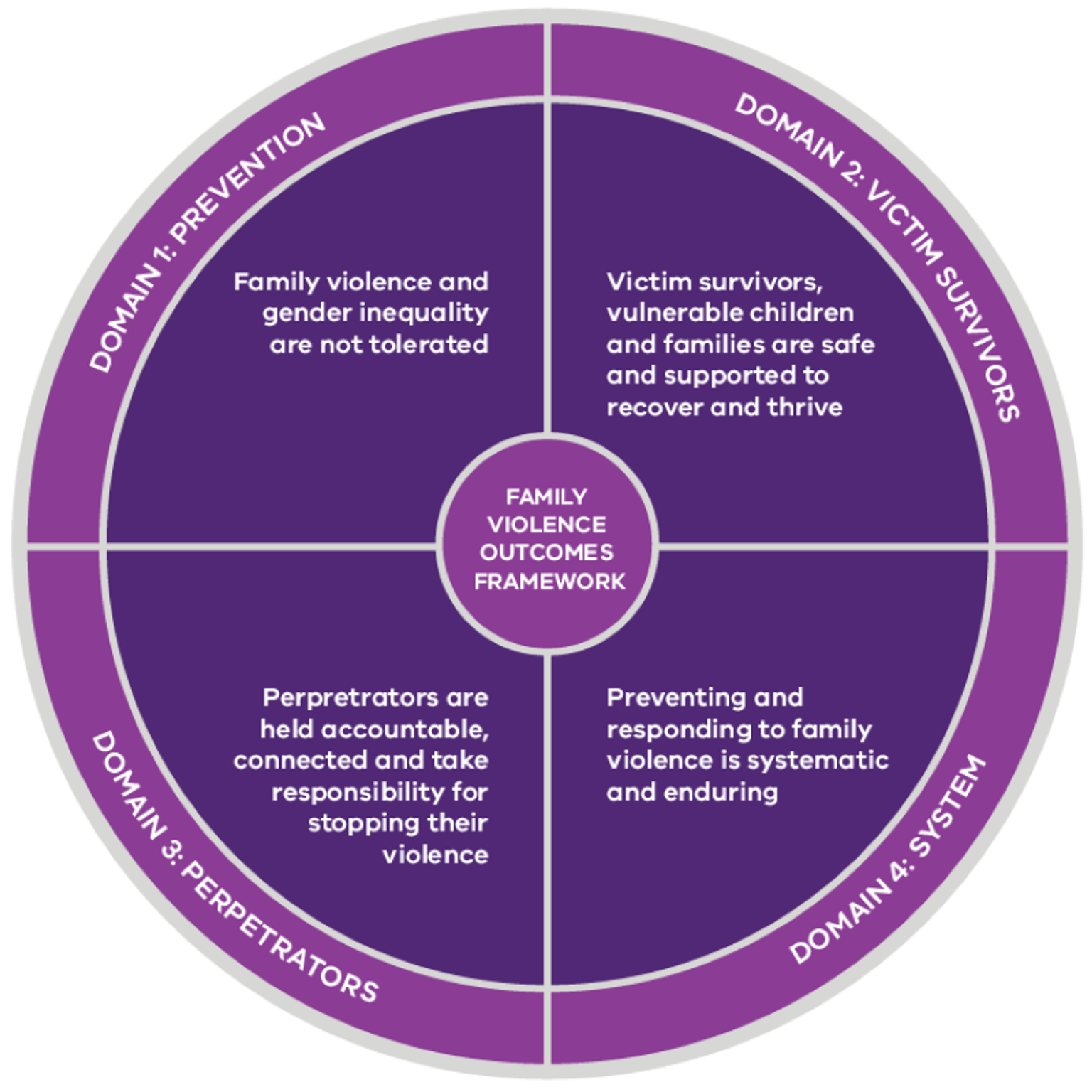The Family Violence Outcomes Framework translates our vision for a Victoria free from violence into a quantifiable set of outcomes, indicators, and measures.
The framework comprises four domains that reflect the long-term changes we want to achieve through our family violence reforms. These are:
- Prevention: Family violence and gender inequality are not tolerated
- Victim Survivors: Victim survivors, vulnerable children, and families are safe and supported to recover and thrive
- Perpetrators: Perpetrators are held accountable, connected, and take responsibility for stopping their violence
- System: Preventing and responding to family violence is systemic and enduring
Each domain contains a set of outcomes, indicators and measures. A short definition for each of these terms is provided in the table below.
Definitions of outcomes, indicators and measures
| Term | Definition |
|---|---|
| Outcomes | Articulate what success looks like, and are clear, unambiguous, high-level statements about the things that matter to prevent family violence in Victoria |
| Outcome indicators | Specify what needs to change to achieve each outcome and set the direction of change, for example, are we looking for an increase or decrease? |
| Outcome measures | Provide the more granular and specific details about what will change and how we will know if we are making progress. They enable us to determine the size, amount or degree of change achieved |
The Family Violence Outcomes Framework measurement and monitoring implementation strategy sets out our staged approach to measuring and monitoring the outcomes of family violence reform in Victoria.
This approach is founded on our understanding that it will take time to address data gaps, strengthen the validity and reliability of data sets, and build capability and capacity across the family violence system to collect, analyse, and report outcomes data.
Strengthening how we measure family violence outcomes
The outcomes framework provides a clear focus on the long-term outcomes we are working towards. However, we still have considerable work to do to strengthen the indicators and measures, increase the quality of data we have access to, and use that data in more sophisticated ways.
This will help us better understand the impact of our work and more meaningfully report on the outcomes we are achieving.
There are two key challenges we working to address:
1. Tracking our progress against long-term outcomes
Currently, the outcomes, indicators, and measures relate to long-term goals and use population-level data. While these are important elements of a statewide outcomes framework, they are not sensitive to change in the short-term. This makes it difficult to track our progress as we work towards our long-term goals. When data is at population level, it is also more difficult to measure the impact of reforms on particular communities to inform decision-making about where additional effort or investment may be required.
2. Strengthening data quality and availability
Measuring outcomes and monitoring progress requires different types of data across each of the four domains. For example, the Prevention domain uses program and project-level data gathered through community partners that are delivering primary prevention initiatives. The data relates to the specific projects they deliver and there is little consistency and few systems in place to track the collective outcomes of these projects.
The Victim Survivors, Perpetrators and System domains rely heavily on service delivery data, which comes from four key datasets: police incidents, intake (The Orange Door, Safe Steps and Men’s Referral Services), case management and refuges, and program data from both therapeutic programs and Men’s Behaviour Change Programs.
The systems supporting these datasets were developed at different times and sit on different platforms that do not to talk to one another. This makes it difficult to track client journeys through the family violence system and therefore measure outcomes.
These challenges are not unique to Victoria. Strengthening data collection systems is also a key priority under the National plan to end violence against women and children (2022–2032).1
To address these challenges, we will:
- develop meaningful short- and medium-term indicators and measures
- identify data sources for all measures by mapping reform initiatives, exploring opportunities to link datasets, and creating new data sets to address gaps
- enter into data-sharing agreements with data custodians to develop linked datasets and mandate how data is collected and analysed
- develop a data improvement strategy to strengthen data quality, reliability, and availability
- develop data collection tools and systems to report and analyse data, and integrate them into programs, services, and evaluations
- disseminate guidance materials that are clear, specific, and practical to implement.
Domain overview and related data
Footnotes
1 Commonwealth Government 2023, National plan to end violence against women and children 2022–2032, p. 27. https://www.dss.gov.au/sites/default/files/documents/11_2022/national_p…
Updated
